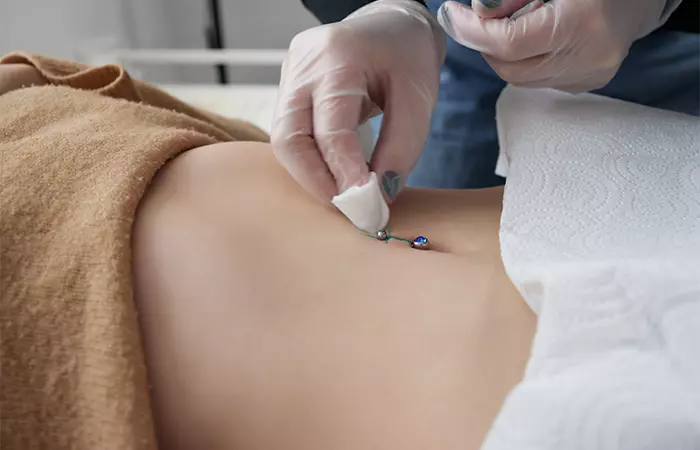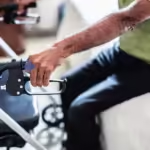Are you thinking about getting a belly piercing? But you are afraid of the pain you feel. Belly button piercing pain is a common concern among many people. Some people love this trendy body modification. It is same as any other piercing. The level of pain varies from person to person. Now let us delve in for evaluating the belly button piercing pain scale 1-10!
Understanding Belly Button Piercing Pain:
Let us delve in evaluating the belly button piercing pain scale 1-10. The belly button piercing pain is subjective and varies among individuals.
There are many factors which influence this pain, such as,
- Your pain tolerance, and
- The professionalism of the piercing studio.
They both determine the level of discomfort you will experience during the procedure.
So, if you want to reduce your navel piercing pain level;
- Go to high-quality studios with experienced piercers.
- Prioritize techniques that minimize your pain and ensure a smoother process for clients.
If you are considering a belly button piercing for you. You must acknowledge that pain perception differs from person to person. Some of you may find the procedure relatively painless, while others might experience moderate pain.
Evaluating the Belly Button Piercing Pain Scale (1-10):
One of common methods to determine pain is using pain scale of 1-10. Belly button piercing typically falls within the rage of 3-5. So, its essential for you to recognize that it is not a universal range. It can differ based on personal pain tolerance and individual anatomy.
Your personal anecdotes often highlight the subjective nature of your pain perception. While some individuals may describe the pain as minimal or tolerable, others may find it more intense. Therefore, it’s a crucial to approach the pain assessment for naval piercing with an understanding of its variability.
Belly Button Piercing Healing Process:
Now, let me introduce you with the healing process for belly button piercings. Belly button piercing healing time typically spans three to eight months, during which proper aftercare is your responsibility. You should use regular saline soaks and gentle cleaning. It will help keep the piercing site clean and promote healing from the inside out. Exercise patience. Refrain from changing jewelry prematurely. This can disrupt your healing process and increase the risk of complications.
Also, adhere to the importance of following aftercare instructions. It will impact the overall success of the piercing. Prioritize proper care and allow sufficient time for healing to minimize the risk of complications and ensure a positive piercing experience.
Post-Piercing Care and Recommendations:
Now, after your belly button piercing is done it is important for you to follow certain post-piercing care:
- Use Saline Soaks: You should daily use saline soaks to cleanse your piercing site. It can reduce the risk of infections. Prepare a saline solution using distilled water and non-iodized salt. Or, you can opt for a piercing aftercare saline solution. Soak your piercing for about 5 minutes and ensure thorough cleaning.
- Gentle Handling of Clothing: Always be careful of the clothing you wear. Especially, during the initial healing period because it can hurt you. Choose loose-fitting clothes that won’t rub against or irritate your piercing. Don’t wear tight or restrictive clothes. They may cause friction and discomfort.
- Maintain Proper Hygiene: Practice good hygiene to prevent bacterial buildup and infection. Avoid touching your piercing unnecessarily. Wash your hands thoroughly before handling the area. Always use mild, fragrance-free soap to clean your piercing site. Do it during your regular shower routine.
- Avoiding Using Any Irritants: Avoid using potential irritants that can exacerbate discomfort. They can delay your healing process. Refrain from applying any harsh chemicals, lotions, or ointments directly to your piercing area. Avoid swimming in pools, hot tubs, or natural bodies of water. It can increase the risk of infections.
- Choosing Appropriate Jewelry: During your healing process choose high-quality, and hypoallergenic jewelry. Use jewelry that is made from surgical steel, titanium, or gold. The jewelry should be of the correct size and style for your piercing. It can prevent issues like rejection or migration. Avoid changing your jewelry too soon. This can disrupt your piercing’s healing process.
- Monitor Your Healing Progress: Always keep an eye on the healing progress of your belly button piercing. Watch for any signs of infection, such as increased redness, swelling, or discharge. If you feel persistent pain or unusual symptoms, consult a doctor.
Follow these post-piercing care recommendations for the successful healing of your belly button piercing. Always prioritize proper care and attention. Enjoy your new piercing with confidence!
FAQs:
Q1. How much does a belly button piercing hurt on a scale of 1 to 10?
The belly button piercing pain normally ranges from 3-5 on a scale of 1 to 10.
Q2. What is the pain of a belly button piercing compared to?
The pain of a belly button piercing is the same as other piercings. It is moderate and often described as a manageable discomfort.
Q3. Which is the most painful piercing?
The pain varies among individuals. Mostly piercings in sensitive areas like the cartilage or genitalia are often considered more painful than others.
Q4. What is the pain scale for labret piercing 1-10?
Labret piercing pain can range from 3-6 on a scale of 1 to 10. It also depends on your tolerance and piercing technique.
Q5. How painful is a helix piercing from 1 to 10?
Helix piercing pain is mild to moderate. It ranges from 2-5 on a scale of 1 to 10.
Q6. How much bad does an industrial piercing hurt on a scale of 1 to 10?
The industrial piercing pain varies, but it’s generally moderate among individuals. It normally ranges from 4-6 on a scale of 1 to 10.
Conclusion:
If you are getting a belly button piercing. First, evaluate the belly button piercing pain on a scale of 1 to 10. It involves your individual pain tolerance, piercing studio quality, and aftercare practices. You should understand the factors influencing pain perception and follow proper aftercare guidelines for a better experience. You can experience a smoother healing process and enjoy their stylish belly button piercings without complications. But always Remember to consult a professional piercer for personalized advice and care recommendations.
Medical Disclaimer: The information provided in this content is for educational purposes only and should not be considered as a substitute for professional medical advice, diagnosis, or treatment.
Disclaimer: The content on Wellness Derive is for informational purposes only and not a substitute for professional medical advice, diagnosis, or treatment. Always consult a healthcare provider for medical concerns.



